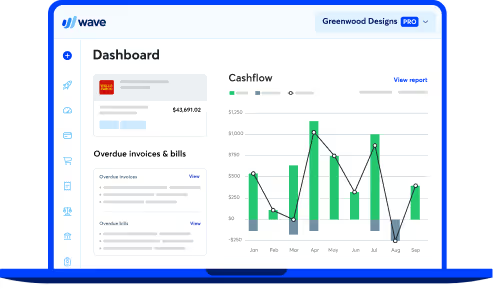
Sole proprietorship taxes: What they are and how to file them
Tax time comes with a lot of feelings: some good—like knowing you’re checking a must-do off your to-do list—and other feelings that are less good. You know: fear, dread, and stress, just to name of few.
Fear not, friends. When you have the basics of sole proprietorship taxes down, well, tax time becomes a little less scary and a whole lot more manageable.To get you to that point, we’ll use this article to cover:
- How sole proprietorships are taxed as pass-through entities, and what that means for your tax return
- If LLCs pay sole proprietorship taxes (spoiler: yes)
- How to determine sole proprietorship taxable income (sole proprietors don’t have to pay taxes on the full amount of the business's income–just on on their business's profits)
- Sole proprietorship tax deductions that you can take advantage of to (hopefully) save you some money
- How and when to file sole proprietorship taxes
Let’s get started. ⬇️
How are sole proprietorships taxed?
Before we answer how sole proprietorships are taxed, let’s make sure we’re on the same page about what a sole proprietorship is: a business structure that’s unincorporated, and has only one business owner who’s not legally separate from the business. Think of freelancers, artists, and shop owners–many of those professionals are often sole proprietorships.
As a sole proprietor, you’re solely responsible for any debts and tax obligations the business accumulates. Which brings us to our next section: tax time and the definitions that come with it.
When it comes to taxes, a sole proprietorship is considered to be a pass-through entity. The term comes from the idea of how a business’s income “passes through” to the business owner. The owner then reports it on their personal income tax return, cutting back on paperwork at tax time—yay!
Now for a breakdown of the types of taxes. Here are the various kinds you’ll have to pay as a sole proprietor:
- Federal income tax
- State income tax (if applicable in your state)
- Self-employment tax
- Federal and state estimated taxes
- Sales tax (if applicable for your business)
More details below.
Federal and state income tax for sole proprietors
As a sole proprietor, you’ve got two tax forms to fill out for your federal income tax: the 1040 (your individual tax return) and the Schedule C (your business’s profit and losses). You’re also required to file a Schedule SE with these returns, plus pay self-employment taxes on a quarterly basis.
Now let’s talk about tax brackets. Remember when we mentioned the whole “pass-through entity” thing? This makes an impact on your personal taxable income. Here’s why: as your business’s net income passes through to you—the business owner—you end up with more taxable income, putting you in a higher tax bracket.
Also good to know? Sole proprietorship taxation means that the income taxes you pay aren’t considered business expenses. So, you can’t post your income tax payments on a profit and loss statement as business expenses. Instead, they’re considered as distributions of equity.
Lastly, state laws. If you’re operating in a state that assesses income tax, the income numbers from federal tax forms are carried over to any applicable state tax ones. They’re all different, so make sure you check based on your own state.
Self-employment taxes for sole proprietors
Remember those days when you worked for someone else and your pay would have Social Security and Medicare “magically” deducted from your salary? Now it’s your turn to make some magic. Spoiler: there’s no magic spell, but there is a tried-and-true calculation.
If you’re a sole proprietor who’s completely self-employed, you’ll need to take the Social Security and Medicare taxes out of your pay similarly to how an employer would deduct those taxes from a salary.
For 2023, that looks like this:
- 12.4% for Social Security tax—up to the first $132,900 of your income
- 2.9% for Medicare tax
See? Not magic, but pretty close.
Estimated taxes for sole proprietors
Don’t worry—this isn’t a new or separate set of taxes. Estimated taxes are “paid ahead” based on your estimation of what you’ll owe in income and self-employment tax at the end of the year.
This is similar to how an employer will withhold money from their employees’s paychecks, so they can be applied to tax liabilities. But in this case, you’re the employer, so, starting in April, you have to do it for yourself four times a year via Form 1040 ES. That’s when federal and state estimated taxes are due; the last being in January.
Sales taxes
Sell products or services? Then you might have to collect and pay sales tax. The total amount will depend on the state you live in, so check your state’s department of revenue to learn more about the requirements, like when you need to pay and file.
Do LLCs pay sole proprietorship taxes?
Is your business categorized as an LLC? Even if you answered yes, you still might file your taxes as a sole proprietor. This is because LLC is a status granted at the state level, not federal. That means if you’re a single-member LLC, you’re subject to sole proprietorship taxation. For LLC’s that have two or more members, you’re considered a partnership. Regardless of whether you’re solo or in partnership, you can make the decision to file taxes as a corporation with IRS Form 8832.
But listen, this can get a bit confusing, especially if you’re unsure of what your tax status is. If that’s the case, consult with a tax professional or talk to a Wave Advisor.
How to determine sole proprietorship taxable income
Before filing your sole proprietorship taxes with Form 1040 Schedule C, you’ll need to first figure out your taxable income. As we mentioned above, you don’t have to pay taxes on the full business’s income, but just on your profits—essentially total income minus expenses.
This means the sole proprietorship’s taxable income will be close to the "net income" or "net profit" number at the bottom of your profit and loss statement.
This is where good bookkeeping comes in. It’s normal for businesses to deduct expenses on their returns, so if you do that, you’re in good company. That said, in order to make sure you’re correctly reporting these deductions and taxable income accurately, you’ll need to make sure your books are accurate, too.
You’ll also want to be clear on what’s deductible and by how much. Like business meals, for instance. Sure, you can deduct them, but not the full amount. So, even if these expenses show up in your profit and loss statement, they may not actually make the impact you’d expect on your taxable business income.
Sole proprietorship tax deductions
We’ve talked a lot about deductions in this article, so let’s take a look at what sole proprietors can claim to save money at tax time.
- Contributions to self-employed retirement plans, such as a SEP IRA or solo 401(k)
- Traditional individual retirement account contributions
- Contributions to a Health Savings Account associated with a high deductible health plan
- Advertising and marketing expenses
- Interest on business loans
- Education expenses related to the business
- Legal and professional fees
- Telephone and internet service
- Business meals
- Taxes and licenses
Want to learn more about these deductions? Check out our full article on self-employed tax deductions.
Special tax deductions for sole proprietorships
As a business owner, you might be aware of the “non-cash activities” that can lower your taxable income. Here are some common ones that you can use.
Health insurance
Don’t overlook the opportunity to deduct health insurance premiums for you or your family. As a sole proprietor, you’re able to take advantage of this "above the line" deduction, which lets you deduct these premiums before calculating your adjusted gross income. But note: this deduction applies specifically to months when you, your spouse, or other family members aren’t covered by a group insurance plan.
Business mileage
Thinking about forgoing mileage at tax time? Think again. Using your car for business purposes can add up, substantially affect your tax liability. To qualify for this deduction, keep detailed records of your trips. Tip: leave a log in your glove compartment so you can record on-the-go. (Well, not technically on-the-go, but you know what we mean.)
Home office expenses
Have a fear of audits? Don’t let that come in the way of deducting certain home office expenses. If you’re a home-based business, you’re entitled to this deduction, and it can make a big impact during tax time. But remember: this deduction only applies to the portion of your home that’s used exclusively for business. So no, working from the Peloton doesn’t count.
Self-employment tax
As a sole proprietor, you’re responsible for 100% of your social security and Medicare taxes. This is known as self-employment taxes, and it’s at a rate of 15.3% of your net self-employment income. You’re able to deduct 50% of these self-employment taxes, which you can report on Schedule SE.
How to file sole proprietorship taxes
Time for the fun stuff: how to file sole proprietorship taxes. This happens via two forms with your individual tax return: Schedule C and Schedule SE. Let’s dive in.
Schedule C
Schedule C is used to report the profit and loss of your business, plus business mileage, if applicable. You’ll need Schedule C to complete Form 1040 (individual income tax return), and the sole proprietorship tax rate you’ll pay on your business’s income will be the same as your personal income tax rate.
It’s a pretty simple form to fill out, and is broken into five sections that review your income, expenses, cost of goods sold, information on your vehicle, as well as other expenses.
Schedule SE
Schedule SE is filled out by you, and then used by the Social Security Administration to determine your benefits under the social security program.
To fill this out, you'll first complete Schedule C.
And keep in mind: as a sole proprietor, you’re the only one who’s responsible for paying self-employment taxes, and that’s done on a quarterly basis.
When are sole proprietorship taxes filed?
When you’re a sole proprietor, tax time sort of feels all year round. And for good reason.
Depending on your tax return, you might have to file quarterly vs annually. For example, Form 1040 and Schedule C are annual, but Form 941 for your payroll taxes are filed quarterly.
General income taxes for your sole proprietorship align with your personal tax schedule, and are due by April 15 (or October 15 if you have an extension). Then you’ve got your estimated taxes. To avoid penalties for late or incomplete filing, these are due quarterly using Schedule SE.
Get started filing your sole proprietorship taxes now
Tax time is taxing, but the good news? It doesn’t have to be the most daunting time of the year. By understanding when your various taxes are due, how to file them correctly, knowing what you can deduct, and who to ask for help, tax time is just like any other day of the week.
You know, extremely busy and requiring you to be on top of your bookkeeping.
Don’t worry. We can help with that. 👋
(and create unique links with checkouts)
*While subscribed to Wave’s Pro Plan, get 2.9% + $0 (Visa, Mastercard, Discover) and 3.4% + $0 (Amex) per transaction for the first 10 transactions of each month of your subscription, then 2.9% + $0.60 (Visa, Mastercard, Discover) and 3.4% + $0.60 (Amex) per transaction. Discover processing is only available to US customers. See full terms and conditions for the US and Canada. See Wave’s Terms of Service for more information.
The information and tips shared on this blog are meant to be used as learning and personal development tools as you launch, run and grow your business. While a good place to start, these articles should not take the place of personalized advice from professionals. As our lawyers would say: “All content on Wave’s blog is intended for informational purposes only. It should not be considered legal or financial advice.” Additionally, Wave is the legal copyright holder of all materials on the blog, and others cannot re-use or publish it without our written consent.


























